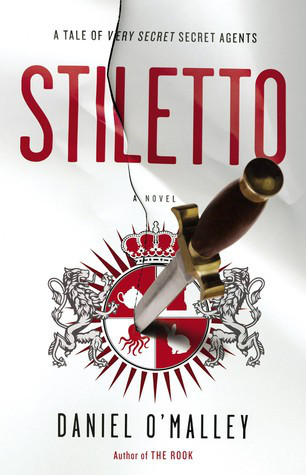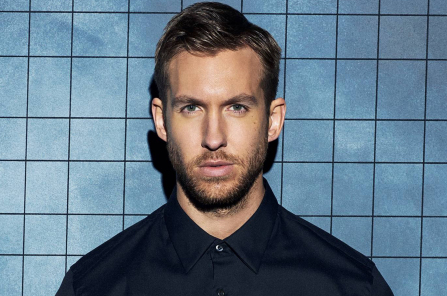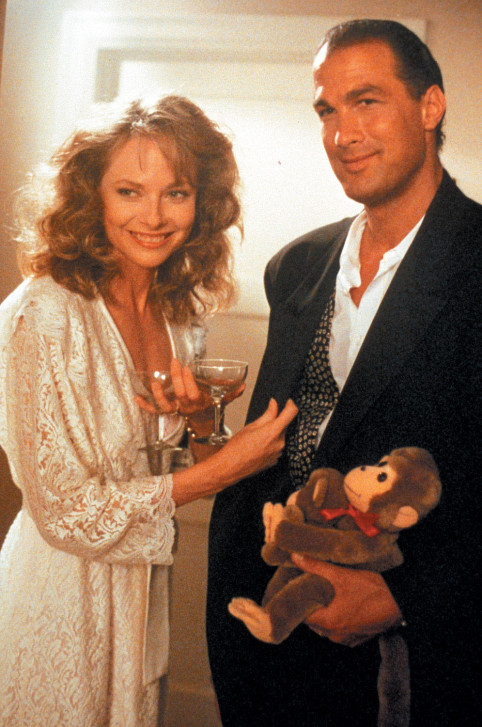
Shit, I was gonna give Steven a stuffed monkey for his birthday!
Kevin: If you felt an excruciating pain when you woke up this morning, it was probably one of your limbs snapping itself in half in celebration of the birth of cinema’s most legendary bone-breaker, Steven Seagal, who was born on this day in Lansing, Michigan 64 years ago. Seagal went on to become one of the most unlikely stars Hollywood has ever produced, and I’m sure future generations will wonder how a glowering, humorless weirdo – who in his movies often came off as more sadistic than the bad guys –briefly became a top box-office draw. Hell, I unabashedly love Seagal’s movies and even I have a hard time explaining it, but I’ll try.
Perhaps the biggest part of his appeal was the fact that Seagal was unlike any action star before or since. When he burst onto the scene in the late 1980s, most action stars like Arnold, Sly, Chuck, and Bruce were Republicans who often kicked righteous ass in the name of America. In contrast, Seagal’s characters were often disillusioned former government agents, and his movies contained explicitly left-wing messages about the dangers posed by American corporations and foreign policy.
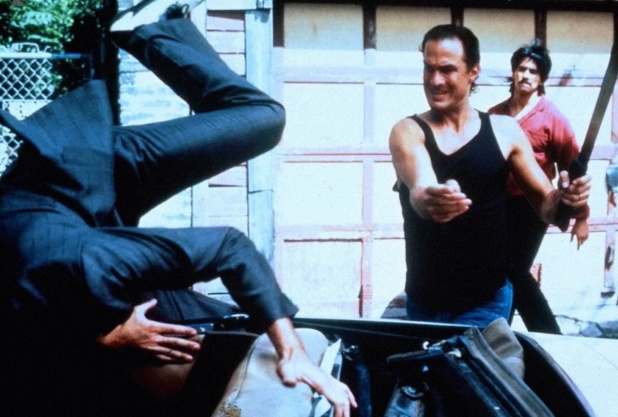
As well as the dangers of pulling a machete on him.
While guys like Arnold and Sly were famous for their post-kill one-liners, Seagal seemed almost incapable of humor, as his reputation as one of the least-liked “Saturday Night Live” hosts in the show’s history can attest. And while even the toughest star would occasionally find himself ever so briefly injured and on the ropes in a movie, Seagal could fight through an entire film and barely get a scratch.
(I remember first watching “Out for Justice” and wondering how they were going to make William Forsythe a believable opponent for Seagal. Turns out they didn’t, Seagal just brutally beats him up for five minutes and then kills him by sticking a corkscrew into his brain).
Also Seagal had a ponytail, which was pretty damn rare.
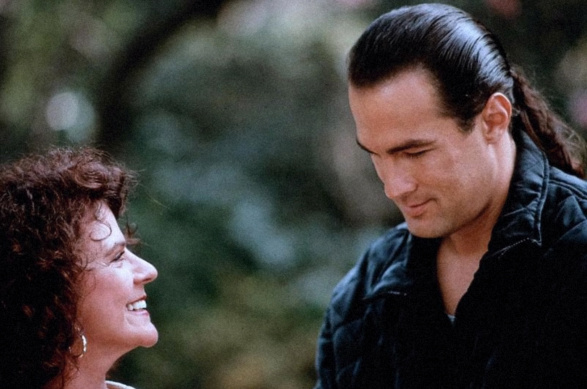
While the details of Seagal’s past are “murky” to say the least, with some hints – usually made by Seagal himself – of possible work for the CIA, it is known that he took an interest in the martial arts discipline of aikido at an early age in America and eventually became the first Westerner to operate a dojo in Japan. Aikido is a fighting style in which you use an opponent’s force against them, and is supposed to be ideal for smaller fighters taking on larger enemies. I’ll take their word for it, as I’ve only ever seen it demonstrated by the 6-foot-4 Seagal against small Asian men, as in this early footage of him demonstrating the “randori,” a test in which a student must fend off multiple attackers for an indeterminate amount of time until his teacher decides he has effective control of the situation:
After returning to America, Seagal followed in the footsteps of Bruce Lee by training a number of celebrity clients including James Coburn, who apparently was so impressed that he brought Seagal along to demonstrate aikido to a national audience on “The Merv Griffin Show” (look out for Coburn at the end when Merv thanks him for bringing the show “another winner”:
While his marriage to “Weird Science” actress Kelly Le Brock certainly increased his profile further, it was another of his celebrity clients – CAA super agent Mike Ovitz – who helped secure him his first starring role in 1988’s “Above the Law,” which Mike and Anthony did their own Tag Team on a few weeks back. Here is how Seagal was introduced to audiences, in an opening credits sequence where he narrates a Hollywoodized version of his upbringing over old photos, as well as gives a demonstration of aikido to unfamiliar American viewers:
But while “Above the Law” was a good introduction for Seagal, it didn’t show us the “range” he was capable of. For that we would have to wait for 1990’s “Hard to Kill,” in which Seagal plays detective Mason Storm, who after being gunned down along with his wife, wakes up from a seven-year coma seeking revenge, and apparently ready to get back into the dating scene after quickly hooking up with his nurse played by Le Brock. Tough Guy Digest has previously highlighted Seagal’s one line reading that should have secured him a seat at the Oscars that year:
But hey don’t take my word for it, even the esteemed critic for the New York Times in her review of “Hard to Kill” called Seagal “the latest and suavest inheritor of the Charles Bronson-Chuck Norris-Bruce Lee action film mantle.” Many actors would be humbled about the idea of following in those footsteps, but thank god humility has never been a trait shared by Steven Seagal, which is why he kept right on going and just a few months later delivered my all-time favorite Seagal flick, “Marked for Death” (which by the way was Twentieth Century Fox’s second-highest grossing movie that year behind “Home Alone”):
There are a number of reasons why I love “Marked for Death”: it has the best fight scenes of any Seagal movie, his best sidekick by far in Keith David, and the best Seagal opponent in Screwface, the leader of a Jamaican drug gang that has rather improbably taken root in a small middle-class town outside Chicago without drawing any attention. As played with gusto by Basil Wallace, Screwface is such an awesome villain that not only does he get his own theme song sung by Jimmy Cliff, but he gets killed TWICE! First he gets beheaded by Seagal in Jamaica, but when Seagal returns to Chicago he discovers Screwface isn’t one man but actually twin brothers.
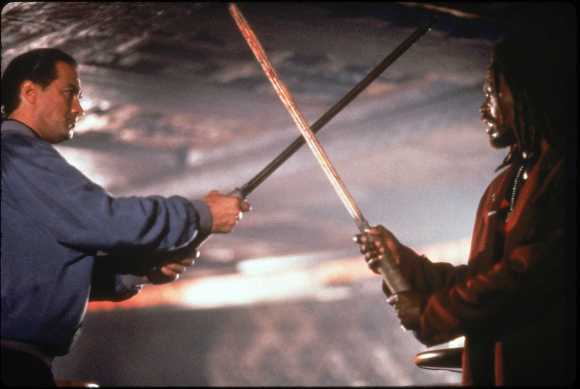
Then during their final battle, Screwface 2.0 becomes the recipient of easily the greatest death in Seagal movie history: Seagal gouges out both his eyes, throws him through a wall, breaks his spine over his knee, and tosses him down an elevator shaft, where he is impaled on a spike below. There is a reason we recommended Screwface as part of a much more badass version of the “Suicide Squad”:
The next year gave us “Out for Justice,” which is largely remembered for the scene in which Seagal appears to be somewhat vexed and perturbed that none of the gents in this pool hall has seen this “Richie” individual he keeps mentioning. While nothing will ever top his “blood bank” line, Seagal in this scene gives a tour de force (and I mean “force” literally) performance as a giant swaggering asshole who insults and then physically assaults people who are doing nothing more than just wanting to shoot some pool in peace:
Since people still enjoyed police brutality back then, Seagal was rewarded with another box office winner, but as his profile increased so did the scrutiny of his murky past and diva-like behavior on movie sets, leading to a GQ profile that was apparently so insulting to the star that he felt the need to address it during a VERY awkward interview with Arsenio Hall:
None of this apparently mattered to audiences, as his next film, 1992’s “Under Siege,” became by far his biggest mainstream hit:
Reteaming with “Above the Law” director Andrew Davis, who would soon nab an Oscar nomination [actually no; see comment section below] for “The Fugitive,” the Seagal in “Under Siege” is unlike any version we had seen up to that point: the ponytail is gone, he actually cracks jokes and seems to be enjoying himself, he holds his own against an A-list co-star like Tommy Lee Jones (whose on-screen rapport with fellow villain Gary Busey is so entertaining you almost hate to see them die).
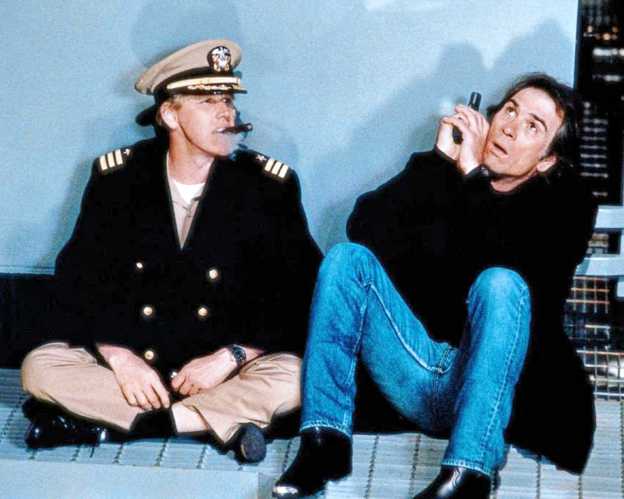
Now this is the buddy comedy I want to see.
By the way, once again Seagal goes for the eyes at the end, gouging out one of Jones’ eyeballs before stabbing a knife into the top of his skull and then shoving him headfirst into a computer monitor. This is after he had ripped a guy’s throat out with his bare hands. All I can say is thank god Seagal is a good guy, because if he ever turned to the dark side he’d be a more sadistic serial killer than Hannibal Lector.
Either way, with the success of the film Seagal was officially on the Hollywood A-list, and the only thing that could derail his career momentum now would be if he used his accumulated clout to make a vanity project/political lecture so well-intentioned yet horribly misguided as to make him a laughingstock. Well ladies and gentleman, I give you 1994’s “On Deadly Ground”:
My friends and I saw “On Deadly Ground” on opening night back before the Internet and sites like Rotten Tomatoes could give you an idea of what to expect beforehand. All we knew was that we were getting another Seagal movie, and up to now they had all been great. I think I speak for most of the people in our audience that night that this scene was the moment we realized the film, directed by and starring Seagal as the Billy Jack-style eco-warrior Forrest Taft, was going off the rails permanently:
There are several things I’d like to highlight about this sequence:
- At the 1:00 mark, Seagal knocks out some cowboy at the pool table who didn’t appear to have anything to do with the fight. What does Seagal have against people trying to play pool?
- Jesus, at the 1:33 mark, did Seagal just cripple an old man? This guy appears to be at least over 70, but Seagal don’t give a shit, he just breaks the dude’s hip and leaves him crumpled on the ground.
- At the 1:40 mark Seagal grabs a guy by the nuts, and just in case you missed it we also hear the guy yell, “My nuts!” Less than 10 seconds later he kicks another guy in the balls, causing him to yell, “My baaaaaalls!” Technically we don’t see those words come out of either of their mouths, but as a director Seagal is a big fan of ADR (automatic dialogue replacement), so at various times during the scene you’ll just randomly hear someone off screen say “Leave him alone you dickhead!” or “This guy doesn’t have a fucking clue.”
- I’m pretty sure none of us in the audience expected that this standard bar fight scene would end with a hand-slap game and the racist oil worker played by Mike Starr experiencing the kind of emotional and psychological breakthrough that 10 years of therapy couldn’t achieve.
- I was always disappointed that we never found out what Mike Starr’s game was going to be. I’m guessing the 1987 edition of Trivial Pursuit.
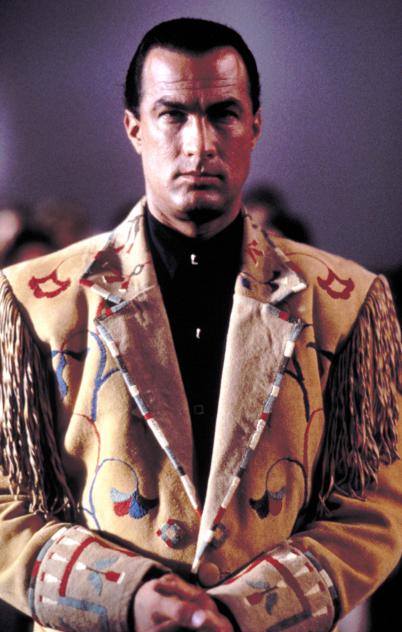
Steven Seagal, a member of the same proud Cherokee tribe as Sen. Elizabeth Warren.
(Side note: As we pointed out in our “Rambo: First Blood Part 2” Round Table, one positive thing you can say about “On Deadly Ground” is that it contains possibly the greatest “Here’s how awesome the hero is” speech in movie history, delivered appropriately enough by R. Lee Ermey):
Following the critical and commercial reception of “On Deadly Ground,” Seagal retreated to familiar territory as everyone’s favorite killer cook in “Under Siege 2,” and in the process delivered one of my favorite action sequels of all time:
Other than the absence of Hall of Fame bad guy duo Tommy Lee Jones and Gary Busey, in many ways I actually prefer the sequel to the original: the action scenes are top-notch, the bad guys – from head villain Eric Bogosian down to henchmen played by the likes of Jonathan Banks – are colorful and memorable, Seagal inflicts some hilariously gruesome and brutal kills, Everett McGill is the rare Seagal opponent who is both his match in size and appearance, and the noticeable extra bulk on Seagal’s frame actually makes him even more imposing and intimidating. Plus Seagal co-starred with a young Katherine Heigl as his niece, and he obviously gave her some great career advice on how to be well-liked in Hollywood.
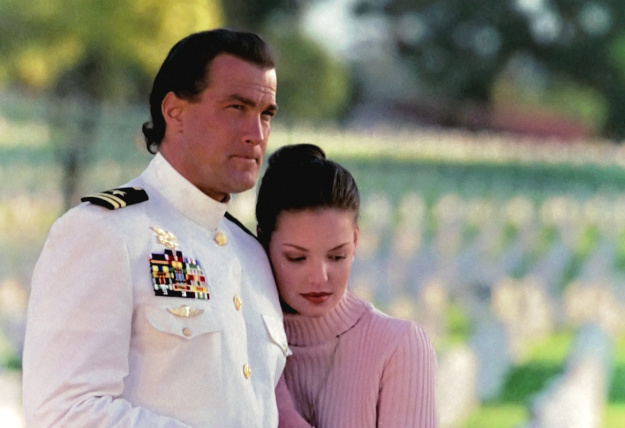
Don’t listen to him Katherine!
With Seagal showing that he could still deliver the goods, my friends and I were beyond excited hearing that he would be starring with Kurt Russell in “Executive Decision.” Steven and Kurt kicking terrorist ass together sounded like a wonderful dream. We didn’t know at the time that not only would Seagal barely make it past the 45-minute mark – sacrificing himself so that Russell and the rest of his team could complete the mission – but that in many ways “Executive Decision” would represent the end of an era for both Seagal and the kind of star-driven, high-concept, R-rated action films that were Hollywood’s bread and butter back in the ‘80s and early ‘90s.
(Just to give you an idea of how the movie landscape was about to change, a few years earlier Warner Brothers was so hot to get the script for “Executive Decision” – written by “Predator” scribes John and Jim Thomas – from Paramount that they traded away a script they had that didn’t seem to have much potential: “Forrest Gump”.)
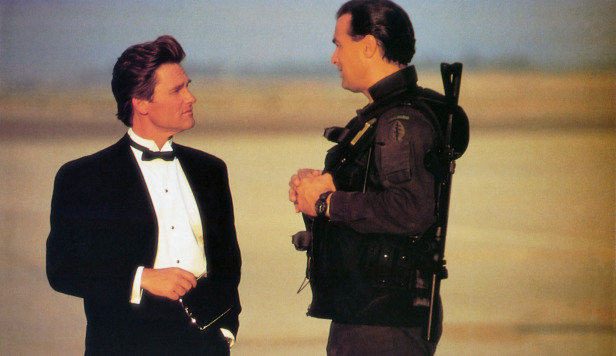
I think history will prove Warner Brothers right on that deal.
Having Seagal’s character get sucked out of a plane and into the atmosphere almost seemed like Hollywood’s way of saying that these kinds of movies were effectively dying off as well, with the rise of the bloodless PG-13 action film making stars like Seagal obsolete. His movies began going direct to video and his co-stars went from the likes of Kurt Russell to Ja Rule. It also must be noted that Seagal’s appearance began to change as well, with both his waistline and his hairline experiencing shocking growth:
But if you think he’s permanently down for the count then you don’t know Steven Seagal (unless you actually do, in which case tell him hi for us!). Hell Mason Storm was in a seven-year coma, and he was back kicking ass and grabbing ass (Kelly Le Brock’s that is) in like a week. As the man said himself in “Hard to Kill,” you may be outgunned and undermanned, but you can always win as long as you have a superior attitude and superior state of mind. And a gun:
PS: If you are a fan of Steven Seagal or want to read a much more in-depth analysis of his entire oeuvre, you should immediately buy yourself a copy of “Seagalogy” by the world’s foremost expert in all things Seagal, film critic Outlaw Vern.
Share this: